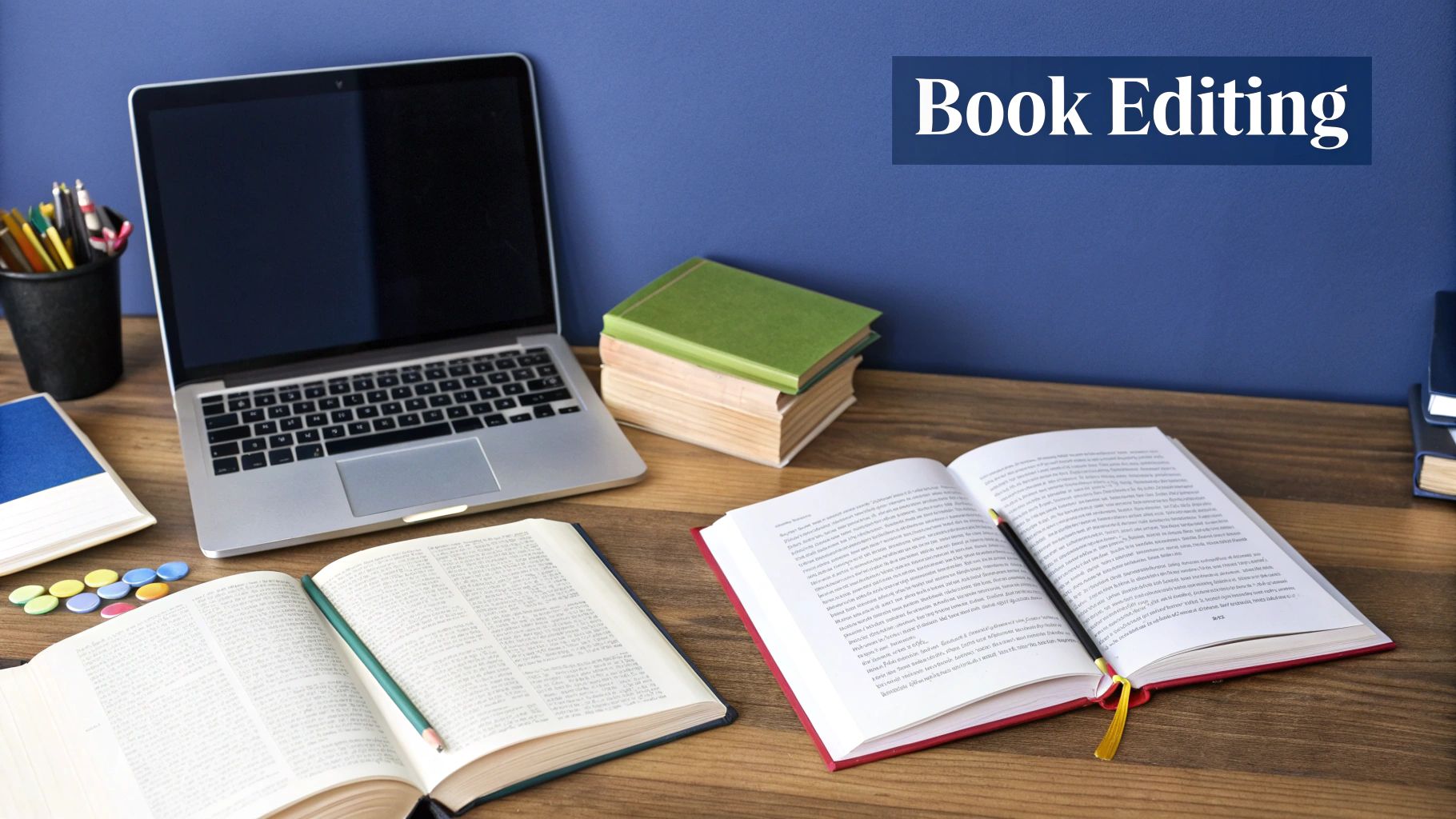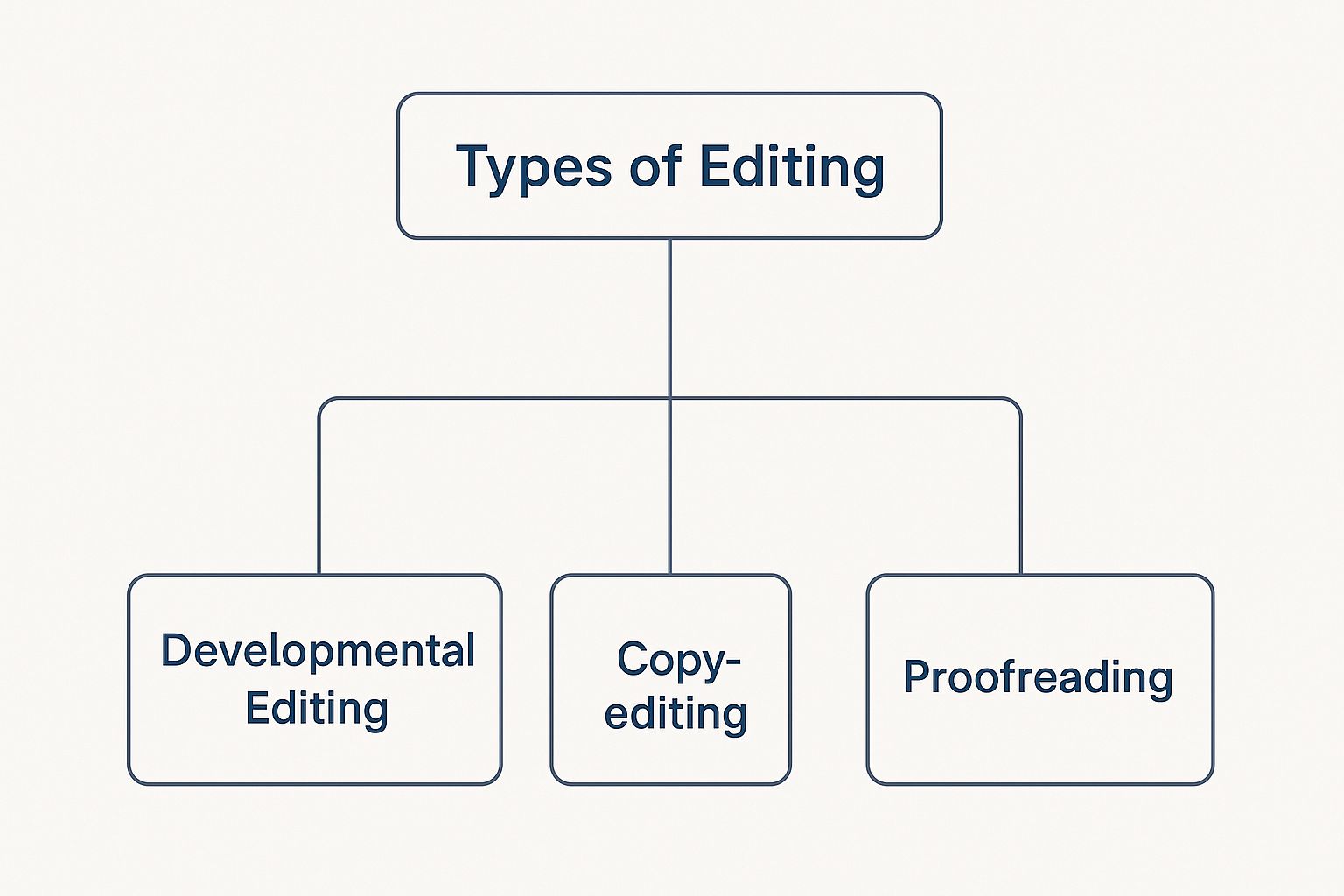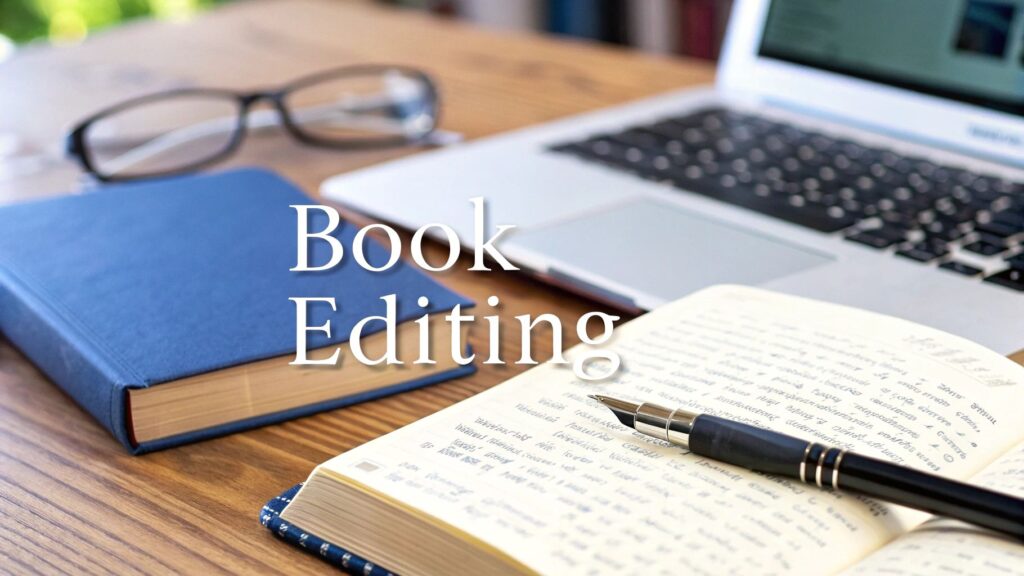Think of your first draft as a rough slab of marble—full of promise but waiting for a master sculptor to reveal its shape. Professional book editing services bring that sculptor’s touch, guiding your manuscript from rough concept to a story that resonates with readers.
Your Manuscript’s Journey From Draft To Masterpiece

Finishing your draft might feel like the end of the road, but it’s really the start of something bigger. Editing digs deeper than spell-check—it sharpens your narrative, polishes your voice, and ensures every sentence earns its place.
When you team up with a professional editor, you gain an experienced reader and guide. They spot the gaps you’ve glossed over, strengthen your plot’s momentum, and fine-tune your language so nothing pulls a reader out of the moment.
Why Every Author Needs An Editor
Self-publishing has exploded in recent years, but that surge means standing out requires top-notch quality. More than 1.7 million new books hit the market last year, and the demand for editing support is only growing. In fact, the global editing sector is on track to reach USD 1.5 billion by 2025.
An editor helps you deliver on your promise to readers by ensuring your manuscript is:
- Cohesive and Clear: Eliminates plot holes, confusing passages, and pacing hiccups.
- Polished and Professional: Eradicates typos, grammar slips, and formatting issues.
- Market-Ready: Increases your chances of earning rave reviews, attracting agents, and boosting sales.
A professional editor isn’t just there to correct errors; they’re your creative partner, helping you sculpt a story that lingers in readers’ minds.
Navigating The Four Essential Stages of Book Editing
Think of editing your book less like a single event and more like a series of specialized check-ups, each with a very specific job to do. You wouldn't ask a heart surgeon to set a broken bone, right? In the same way, you don’t ask a proofreader to fix major plot holes. Understanding the different stages of professional book editing services is key to giving your manuscript the right care at the right time.
The editing journey has a natural order, and each step perfectly sets up the next. Trying to do them out of order is like trying to paint a house before the walls are even built—it's messy, counterproductive, and ends up creating a lot more work. By following the process, you systematically take your book from a rough idea to a polished, final product.
To help you visualize this journey, here’s a breakdown of the four main stages of editing.
The Four Stages of Professional Book Editing
This table lays out each stage, showing you what it focuses on and when it’s most needed.
| Editing Stage | Main Focus | When It's Needed |
|---|---|---|
| Developmental Editing | The big picture: plot, characters, structure, and pacing. | Early on, once you have a complete or mostly complete first draft. |
| Line Editing | The writing itself: style, voice, flow, and sentence-level clarity. | After the developmental structure is solid and major revisions are done. |
| Copy Editing | The technical details: grammar, spelling, punctuation, and consistency. | When the content and style are finalized, but before formatting. |
| Proofreading | The final check: catching typos and formatting errors in the final layout. | The very last step before the book goes to print or is published. |
Each of these stages builds upon the last, ensuring a thorough and professional outcome for your manuscript. Now let's dive into what each one really involves.
H3: Developmental Editing: The Architectural Blueprint
First up is developmental editing, which is all about the big picture. Think of a developmental editor as the architect for your story. They aren't looking for misplaced commas; they're examining the very foundation of your book. Is the plot solid? Are the characters compelling and their motivations clear? Does the pacing keep the reader turning pages?
This phase often leads to big, transformative changes. You might end up rearranging chapters, deepening a character’s backstory, or completely rethinking a major plot twist. It’s an intense but incredibly valuable collaboration that makes sure your story’s core is strong. For a closer look at this crucial first step, you can learn more about what developmental editing is and how it builds a powerful narrative.
H3: Line Editing: Honing Your Voice and Style
Once the structure is locked in, we zoom in to the sentence level with line editing. Your line editor is like a master craftsperson, carefully polishing every single sentence to make it shine. Their goal is to refine your unique authorial voice, improve the rhythm of your prose, and ensure your word choices are as powerful and precise as possible.
A line editor is constantly asking questions like:
- Does this sentence flow smoothly into the next one?
- Is the tone right for the mood of this scene?
- Are there any clichés or awkward phrases that are dulling the impact?
This stage is all about making your language sing. It’s what creates that seamless, immersive experience for the reader.
This diagram helps visualize how the broad, foundational work of developmental editing comes before the more granular, technical reviews.

As you can see, each type of editing tackles a different layer of your manuscript, moving from the biggest concepts down to the smallest details.
H3: Copy Editing: The Technical Tune-Up
After the story and style are feeling great, your manuscript is ready for copy editing. This is the nitty-gritty technical inspection. A copy editor is an expert on the rules of language, and they meticulously comb through your text to find and fix errors in grammar, spelling, punctuation, and syntax.
A copy editor is your first line of defense against the kind of technical mistakes that can pull a reader right out of the story. They enforce consistency, making sure character names, timelines, and key details stay the same from beginning to end.
They apply a consistent style guide (like the Chicago Manual of Style) and catch every last typo or misplaced comma that might have been missed in earlier edits. This detailed work is what makes a manuscript look truly professional.
H3: Proofreading: The Final Polish
The very last stop before publication is proofreading. This happens after the book has been designed and formatted for printing or digital release. A proofreader gives the final version one last look-over. Their only job is to catch any lingering typos, formatting glitches, or punctuation mistakes that have somehow slipped through the cracks.
This isn't the time for rewriting sentences or making story changes; it's purely a final quality check. The proofreader’s fresh eyes are essential because they can spot minor flaws that you and your editors—who know the text inside and out—are likely to miss. This final step ensures your book is as close to perfect as possible before it finally reaches your readers.
Why Professional Editing Is a Non-Negotiable Investment

In a world overflowing with content, a great story idea just isn't enough to stand out. Think of your raw manuscript like a diamond in the rough—the potential is there, but it needs a master cutter to reveal its true brilliance. Professional editing is that final, crucial polish that transforms your hard work into a gem that readers can't put down.
Skipping this step is a huge gamble. A book filled with typos, plot holes, or awkward sentences can sink before it ever has a chance to swim. Readers are sharp, and those first few negative reviews can stick to an author's reputation for years, branding the work as amateurish.
Building Reader Trust and Credibility
A professional editor is your first true reader and your book's biggest champion. Because you're so close to the story, you can't see the tiny flaws—the plot point you dropped in chapter three or the character whose motivation suddenly changes. An editor brings a fresh, expert eye to catch those things for you.
Their job is about so much more than just fixing commas.
A great editor will:
- Enhance the Reading Experience: They smooth out clunky sentences and fix awkward pacing, creating a seamless flow that keeps your reader completely immersed.
- Strengthen Your Story: They’ll push you to dig deeper into your characters, patch up plot holes, and make sure your narrative is as compelling and satisfying as it can be.
- Boost Your Authority: A clean, professionally presented book instantly establishes your credibility and shows you respect your readers' time and investment.
Investing in an editor is really an investment in your reader’s trust. When your book is clear, compelling, and error-free, readers are more likely to enjoy it, leave positive reviews, and tell their friends about it.
Navigating the Modern Publishing Landscape
The self-publishing boom has completely changed the game. Authors now have incredible freedom, but they've also inherited all the responsibilities that a traditional publisher used to handle. This means you're in charge of the entire editorial process, from the big-picture developmental edit right down to the final proofread.
This new reality puts immense power in your hands, but it also carries great responsibility. Your editor essentially steps into the role of the quality control expert, ensuring your book is ready to compete with traditionally published titles.
Ultimately, professional editing is non-negotiable because it’s the cornerstone of crafting high quality content and audience trust. It's what turns a personal passion project into a professional product ready to find its audience and win them over.
How to Budget for Professional Editing Costs
Let's talk money. Figuring out the cost of editing is a huge piece of the publishing puzzle for any author, but there's no simple price tag. Think of it less like buying a product off a shelf and more like commissioning a custom piece of art. The final price depends entirely on the project.
A sprawling, 120,000-word epic fantasy with a dozen character arcs is a much bigger undertaking than a lean, 50,000-word business book. The editor's quote will always reflect the unique demands of your manuscript.
Common Pricing Models Explained
Most professional editors use one of three main ways to structure their fees. Getting familiar with them will help you make sense of the quotes you receive.
- Per-Word Rates: This is the industry standard, especially for copy editing and proofreading. It's wonderfully straightforward—you know the exact cost based on your word count. No surprises.
- Hourly Rates: You'll often see this for developmental editing. This kind of big-picture work is more about deep thinking and consultation than just correcting commas, so an hourly rate makes more sense for the editor.
- Flat Project Fees: Some editors prefer to give you a single, all-in price for the whole job. This is great for budgeting because you know the total investment from day one, no matter how many hours it takes.
What Influences the Final Cost
So, what actually determines that final number? Several key factors come into play. The more work your manuscript needs, the higher the investment will be. For a complete look at what you can expect, our detailed guide on how much book editing costs breaks down specific price ranges.
Here are the main things that will affect your quote:
- Type of Editing: Developmental editing is the most involved and, naturally, the most expensive. Line editing is next, followed by the more affordable copy editing and proofreading stages.
- Manuscript Length: More pages simply mean more time and work for the editor. This is a direct driver of cost.
- Subject Complexity: A deeply researched historical novel or a technical guide requires a lot more from an editor than a straightforward memoir.
- Editor Experience: A seasoned pro with a stellar track record and a long list of successful books will charge more than someone just starting out. You're paying for their expertise.
It’s tempting to hunt for the cheapest deal, but remember this: editing is an investment. It’s an investment in your book’s quality, your credibility, and your readers’ experience. The right editor brings a value that far exceeds their fee.
For a little more context on how creative professionals set their prices, you might find it helpful to look at guides on understanding professional service costs in other fields. At the end of the day, budgeting for an editor is about finding that sweet spot between what you can afford and what your book truly needs to succeed.
How to Find the Right Book Editor for Your Manuscript

Choosing an editor is a huge decision. Think of it like casting the most important supporting character in your book's real-life success story. This is a partnership, one that hinges on trust, a shared vision for your manuscript, and a very specific set of skills. The right editor will elevate your work, making it shine in ways you hadn't imagined. The wrong one? That can lead to a lot of frustration and a book that never quite hits its potential.
Your mission is to find that perfect match—a professional whose expertise is precisely what your project needs. A quick search for professional book editing services will give you a dizzying number of options, so the trick is knowing how to sift through them effectively.
Where to Find Reputable Editors
Finding a genuinely qualified editor means looking in the right places from the get-go. If you start your search on trusted platforms, you'll save yourself a ton of time and avoid the headache of vetting people who just aren't up to snuff.
Here are a few of the best places to begin your search:
- Professional Organizations: Industry groups like the Editorial Freelancers Association (EFA) or the Chartered Institute of Editing and Proofreading (CIEP) are gold mines. They maintain searchable directories of members who have already met strict professional standards.
- Curated Marketplaces: Sites like Reedsy and Jericho Writers aren't just free-for-alls. They connect authors with a hand-picked pool of editors, and you can usually browse portfolios, read client reviews, and see rates right away.
- Author Referrals: Don't underestimate the power of your network. Reach out to other authors, especially those in your genre, and ask who they've worked with. A personal recommendation is often the most reliable way to find an amazing editor.
Evaluating Potential Candidates
Once you've built a shortlist of promising editors, the real work begins. It’s not just about finding a good editor; it’s about finding your editor—the one who gets your book. For a much deeper look at this, our guide on how to find a book editor walks through the process step-by-step.
You're looking for a trifecta: genre expertise, a strong portfolio of past work, and glowing reviews from other authors. An editor who lives and breathes historical romance will catch nuances that someone who primarily edits business books would completely miss.
The single most important step in the hiring process is the sample edit. Ask your top two or three candidates to edit a small portion of your manuscript (usually 1,000–2,000 words). This is the only way to truly assess their style and see if their feedback resonates with your authorial voice.
Questions to Ask Before You Hire
Before you sign any contracts or send any money, have a real conversation. This is your chance to get on the same page, understand their workflow, and make sure your personalities and professional styles click.
Come prepared with a few key questions to make sure all your bases are covered:
- What is your experience with my specific genre?
- What does your editing process look like, and what are the key deliverables? (e.g., an editorial letter, tracked changes in Word)
- How do you prefer to communicate, and how often will we be in touch?
- What is your estimated timeline for completing the project?
- Can you provide a contract that outlines the scope of work, fees, and deadlines?
Putting in this effort upfront allows you to hire with confidence. You'll know you've found a true partner who is just as invested in your manuscript's success as you are.
Common Questions About Book Editing Services
Even with a solid grasp of the different editing stages, it's completely normal for authors to have a few lingering questions. Deciding to bring in a professional editor is a huge step, and you want to be sure you know what you’re getting into. Think of this as your final briefing before you take your manuscript to the next level.
Getting straight answers to these practical questions helps you map out your budget, your timeline, and your own expectations. It’s all about moving forward with confidence, knowing you’re ready for the collaboration ahead.
How Long Does Professional Book Editing Take?
This is probably the number one question I get, and the honest answer is: it depends. The timeline for editing can swing pretty widely based on your manuscript's length, how complex the subject is, and which type of editing you need. Of course, the editor's own schedule plays a big part, too.
But to give you a ballpark idea, let's use an 80,000-word manuscript as an example:
- Developmental Editing: This is the heaviest lift. Because it involves a deep dive into your book's structure, plot, and characters, expect it to take anywhere from 4 to 8 weeks.
- Line and Copy Editing: This is more focused on the sentence level, so things move a bit faster. You're typically looking at 2 to 4 weeks.
- Proofreading: The final polish. This is the quickest stage, usually wrapped up within 1 to 2 weeks.
Always, always talk about timelines with a potential editor before you sign anything. You need to make sure their availability works with your publishing goals.
Can I Just Use Software Instead of a Human Editor?
Look, tools like Grammarly are great. They're fantastic for zapping basic typos and grammatical slip-ups. But they are absolutely no substitute for a professional human editor. Think of editing software as a helpful spell-checker on steroids—it can't appreciate the art of storytelling.
AI and grammar checkers are blind to the things a human expert spots instantly. They miss:
- Context and Nuance: Software has no idea what sarcasm, subtext, or the delicate emotional tone of a scene feels like.
- Narrative Flow: It won’t tell you that your pacing in chapter three is dragging, that a character's arc feels unearned, or that a plot hole is big enough to drive a truck through.
- Authorial Voice: A good editor works to amplify your unique style. Software, on the other hand, often tries to sand it down with generic, one-size-fits-all suggestions.
A human editor provides the critical, subjective feedback on storytelling that software simply cannot replicate. They are your creative partner, not just a correction tool.
The explosion of digital publishing really drives this point home. The market for professional book proofreading services is evolving right alongside it. With global ebook sales projected to climb to $14.92 billion by 2025 and online book sales forecasted to hit $48.27 billion by 2034, readers have more choices than ever—and less patience for mistakes. You can dive deeper into the trends shaping the proofreading market at Infinity Market Research.
What Should I Have Ready Before Hiring an Editor?
To get the most bang for your buck, you need to do a little prep work. Sending a messy first draft to an editor is a fast way to burn through your budget and their time. Before you start reaching out, get your ducks in a row.
First, you need a finished manuscript. That means you've taken it as far as you can on your own and have done your best to self-edit. You should also have a clear idea of your book's target audience and genre—this is crucial for finding an editor with the right kind of experience.
And finally, be ready to receive constructive criticism. It's not always easy to hear, but it's a vital part of the process and will make your book infinitely stronger.
Ready to turn your manuscript into a masterpiece? The expert team at BarkerBooks offers a full suite of professional editing, design, and publishing services to bring your story to the world. Start your publishing journey with us today!
